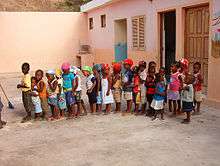Education in Cape Verde
| Ministry of Education, Family, and Social Inclusion | |
|---|---|
| Minister | Maritza Rosabal |
| General details | |
| Primary languages | Portuguese |
| Literacy (2010) | |
| Total | c. 75-80% |


Primary school education in Cape Verde is mandatory between the ages of 6 and 14 years and free for children ages 6 to 12.[1] In 1997, the gross primary enrollment rate was 148.8 percent.[1] Primary school attendance rates were unavailable for Cape Verde as of 2001.[1] While enrollment rates indicate a level of commitment to education, they do not always reflect children’s participation in school.[1] Textbooks have been made available to 90 percent of school children, and 90 percent of the teachers have attended in-service teacher training.[1] Its literacy rate as of 2010 ranges from 75 to 80% and being the highest in the whole of West Africa south of the Sahara.
Although most children have access to education, some problems remain.[1] For example, many students and some teachers speak Cape Verdean Creole at home and have a poor command of Portuguese (the language of instruction); there is insufficient spending on school materials, lunches, and books; and there is a high repetition rate for certain grades.[1]
History
For much of the nineteenth century, education in Cape Verde was primarily undertaken at the initiative of private individuals or groups at a local level, rather than state organisation. The first government-funded primary school was established on the islands of Brava, Cape Verde in 1847. The first secondary school was set up, in Praia in 1860, but this school closed after a year.[2]
In 1866, a clergy-run Christian seminary named the Seminário-Liceu was started in São Nicolau,[3] primarily to train priests, although not all students were ordained. The curriculum covered mathematics, science, classical languages and European literature.[2]
After the Portuguese revolution of 1910, the Seminário-Liceu was replaced by the Liceu Nacional de Cabo Verde in 1917 and moved it to the island of São Vicente in Mindelo. Liceus Gil Eanes (today it is known as Escola Jorge Barbosa) and D. Infante Henrique (now Liceu Ludgero Lima) were the only secular schools in Cape Verde until 1960,[3] . Another religious seminary would be São José located south of the center of Praia near the island's southernmost point Ponta Temerosa.
More secondary schools opened, including one in Espargos in Sal, Porto Novo in Santo Antão, São Filipe on Fogo, Sal Rei on Boa Vista, in Assomada and Tarrafal, both on Santiago and José Augusto Pinto in Mindelo on São Vicente. More kindergarten and primary schools opened.
Before independence, literacy rate was climbing, before independence, it was at 25%, higher than Guinea-Bissau's 5% and later the majority of West African nations south of the Sahara as well as Central and East Africa combined. Its literacy rate before the end of the 20th century was about 50%.
Higher education, which did not exist in Cape Verde in the colonial period, was introduced by the creation of Curso de Formação de Professores do Ensino Secundário (CFPES, "Secondary Education Teacher Training Course") on 28 July 1979.[4]:31 On October 2, 1995, CFPES became Instituto Superior de Educação (ISE, "High Education Institute").[4]:44
In 1980 the National Institute of Technological Research (INIT - Instituto Nacional de Investigação Tecnológica) was established. It became INIDA (Instituto Nacionai de Investigação e Desenvolvimento Agrário) in 1997.[4]:68 INAG (Instituto Nacional de Administração e Gestão, National Administration and Management Institute) was established on October 21, 1998, succeeding the 1981 Centro de Formação e Aperfeiçoamento Administrativo (CENFA).[4]:110 Centro de Formação Náutica (CFN - Nautical Formation Centre) was established on June 19, 1982. On October 21, 1996, it became ISECMAR (Instituto Superior de Engenharias e Ciências do Mar, High Institute of Marine Engineering and Sciences).[4]:79-84
ISE, ISECMAR and INAG joined to become the University of Cape Verde (the country's first public university) on November 21, 2006; INIDA joined in 2007.[5] All of the predecessor schools would be eliminated and fully became campuses on October 9, 2008.[6] Uni-CV's university campuses are under development which started construction in 2014.
Cape Verde's only private university opened in 2001 and is called the Jean Piaget University of Cape Verde, it later opened its Mindelo Campus.
In 2009, Universidade de Santiago de Cabo Verde opened in Assomada, later in the early 2010s, the University of Santiago opened. There is also a Lusophone University in Mindelo and Praia.
Some foreign schools are located, most of it in Praia, one is Colégio Internacional – Cabo Verde, a Portuguese school, the other is a French school named École Internationale Les Alizés opened in 1991.
See also
References
- 1 2 3 4 5 6 7 "Cape Verde" Archived May 7, 2008, at the Wayback Machine.. Findings on the Worst Forms of Child Labor (2001). Bureau of International Labor Affairs, U.S. Department of Labor (2002). This article incorporates text from this source, which is in the public domain.
- 1 2 Batalha, Luís (2004). The Cape Verdean Diaspora in Portugal: Colonial Subjects in a Postcolonial World. Lexington Books. p. 76. ISBN 978-0-7391-0797-3.
- 1 2 Thevenod, Alexis D,. "Linguistic Legacies and Postcolonial Identities in West Africa". Portuguese Literary & Culture Studies. 27: 128. Retrieved 15 October 2016.
- 1 2 3 4 5 Varela, Bartholomeu (2013). A evolução do ensino superior público em Cabo Verde: da criação do Curso de Formação de Professores do Ensino Secundário à instalação da Universidade Pública (in Portuguese). Praia: Uni-CV Publications.
- ↑ Historial - Universidade de Cabo Verde
- ↑ Decree-Law no. 29/2008 (PDF). 36. Republic of Cape Verde. 9 October 2008.